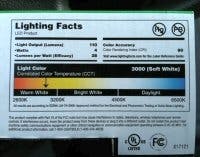After the problem came to light, the Philips lamps group hurriedly joined the program and submitted the required performance data.
Now, it appears that Osram Sylvania has also made its own Lighting Facts label for its 4W PAR16 LED lamp – see image. The label lacks the standard portrait format and other features of the authorized label.
When we checked the Lighting Facts website (on October 12), Osram Sylvania was listed as a partner, but the product in question was not listed.
However, the LED lamp produces only 110 lumens. Even if the conventional 25W lamp has an efficacy of only 10 lm/W, then it still would produce 250 lm. Would the consumer notice this? Our guess is yes.
Such product comparisons, which were also a point of contention for a recently-introduced LED lamp from Lemnis (see News), are not covered by the Lighting Facts program.
DOE comments on Lighting Facts
At the end of September, following our Philips article but before the situation with Osram Sylvania came to light, DOE commented on the Lighting Facts label program. Below, we quote directly from the Postings email authored by Jim Brodrick, who runs the DOE’s SSL program:
“In our effort to monitor how the Lighting Facts label is being used, we have unfortunately discovered that some manufacturers have copied or reproduced the label without going through the relatively simple and straightforward process required by the program.
This is simply unacceptable for two key reasons. First, the Lighting Facts label is registered to the U.S. Department of Energy, and as such, cannot be reproduced or recreated without express permission. Secondly, each product that is registered with the program is designated a unique label. This is the only version of the label that can be used with that specific product and it cannot be altered or re-created.
With each case that DOE learns about, we are taking immediate action to investigate the violation and insist on conformity with the program requirements. You will also see that DOE has made some recent changes to the web site that make it crystal clear that the label can only be used with products that are officially registered and listed on the product list. Additional changes include modifying the label design to make it more difficult to copy.
In order to maintain the program's integrity, it is the responsibility of all of the Lighting Facts partners to be vigilant and help guard against misuse of the Lighting Facts label. There are a couple simple things you need to do:
- When you see the Lighting Facts label on product literature or packaging, please check the Lighting Facts product list on the web site to make sure that it is listed and the metrics are consistent. Only the products that are listed on the web site have been verified to the LM-79 test reports and can display the label.
- Check the Lighting Facts partner list to make sure that the manufacturer of the product is a valid partner.
- Please report any questionable products to me so that we can quickly address any issues.







